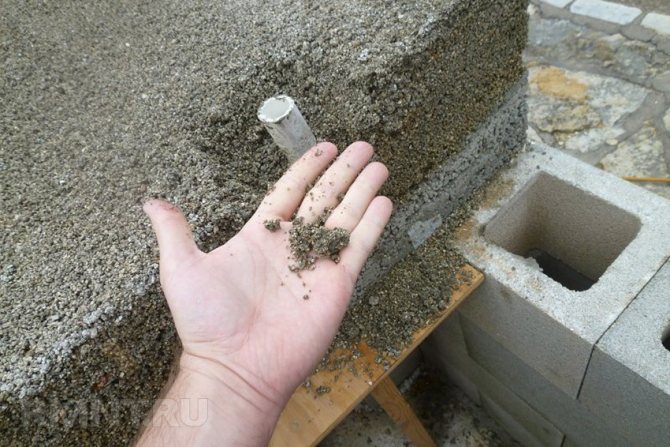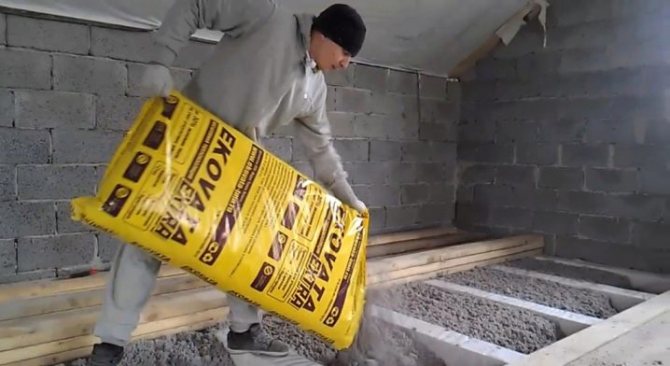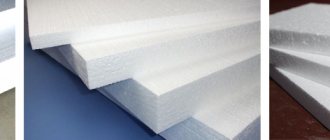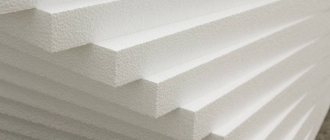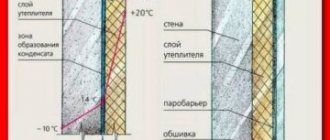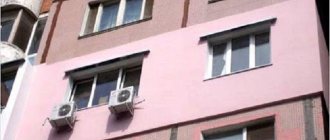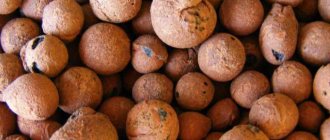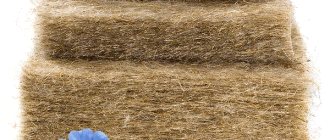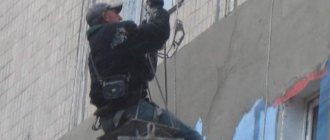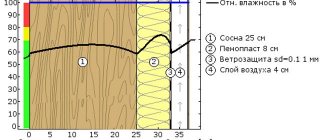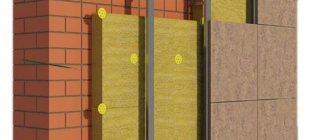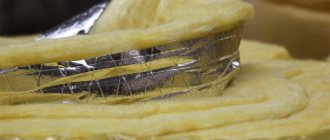Features and Benefits
Insulation is a low-density porous material, the granules of which are produced by firing foamed raw materials at a high temperature. The simplicity of manufacture is reflected in the low cost of thermal insulation, and the structure also saves on labor costs.

The disadvantages of backfill insulation are:
- their shrinkage by 10-15% of the initial volume;
- loss of thermal insulation properties when wet.
Backfill insulation is used, usually for horizontal surfaces. The job seems simple, but requires careful preparation. For example, when insulating the floor in buildings without basements, the soil is previously compacted and covered with a screed. Next, a waterproofing material is laid on the latter, and insulation is poured onto it. It looks like the situation with the insulation of the roof, only the screed is not required. Instead, a vapor barrier is laid on top of the backfill material.
When cladding walls, a frame is pre-built, consisting of durable sheet elements. After that, a heater is poured into the resulting structure.
Types of backfill insulation
Hundreds of years ago, in the construction of wooden houses from timber or logs, the very first backfill insulation was used - sawdust. Like modern counterparts, they were quite good in terms of thermal conductivity, but shrank or lost their properties when wet. Today's materials are more advanced in many ways. The most popular of them are discussed in detail below.
Insulation based on clay. It is used as an independent heat insulator for residential or industrial buildings, and in combination with concrete (expanded clay concrete is obtained). Today it is obtained by firing clay shale.
The production technology varies depending on the required size of the final granules.
Having studied the marking of the backfill insulation, you can understand what size of granules of the material and for which parts of the house it is suitable. For example, expanded clay sand is used as a heat insulator for the floor or acts as a component of concrete sheathing. Granules with a diameter of 5-10 mm are suitable for pitched and flat roofs, floors, attic; larger than 15 mm - for warming a basement or foundation.


Expanded clay inevitably settles during operation, therefore, during the initial installation, it must be strongly compacted in order to minimize shrinkage. It is recommended to insulate the walls with the material only in regions where the temperature in winter does not drop below -20 degrees.
Insulation is made from silicate volcanic rocks using the same technology as expanded clay. When heated to 1000-1200 degrees, moisture evaporates from the surface of the stones, leaving air inside them. The result is white or gray granules with a diameter of 1 to 10 mm. The density of perlite ranges from 75 to 150 kg / m3, and for its color it is also called "glass insulation".
The smallest granules (1-2 mm) form perlite sand used in the following areas:
- insulation of residential buildings;
- production of acoustic materials;
- production of insulating plaster;
- creation of fire-resistant concrete.
Air-filled granules weigh less than expanded clay, therefore they are suitable for thermal insulation of walls. In addition, the material resembles mineral wool, since, in addition to retaining heat, it will prevent the penetration of extraneous noise into the room.


Expanded material from hydrated mica, through heat treatment, increased in volume 15-20 times. Has increased fire-resistant properties, due to which it is used when installing chimneys. Ideal for floors and walls.
A thin layer of vermiculite 5 cm thick will retain up to 70% of the heat of the room. This is enough for roof insulation. For walls, floors and foundations, it is recommended to make a double layer of material.
The density of vermiculite is lower than that of expanded clay or perlite - the largest bulk density is 100 kg / m3. This backfill insulation is supplied in bags of a certain volume, and is used in almost all premises of a residential building.


The advantages of vermiculite include:
- low coefficient of thermal conductivity (0.04-0.06), comparable to foam and mineral wool;
- lack of the likelihood of voids and seams;
- high melting point (1400 degrees);
- absence of toxic materials in the composition;
- biological resistance (prevents mold, fungus, is not of interest to rodents);
- good sound insulation;
- the lightness of the material, allowing it to be used in frame houses, on load-bearing systems or foundations;
- ease of insulation work and time saving.
- Ecowool.
A relatively new material that appeared on the market only 10 years ago. It is made from recycled paper materials, fire retardants (substances that prevent fire), antiseptics. It is safe for humans, resistant to decay, does not spread fire. It is more often used for thermal insulation of walls, mansards or roofs of complex structures.


List of the most requested materials
A thorough review of the materials posted on construction forums and portals allows us to identify the 9 most common types of insulation. Among them are sand, sawdust, small shavings, vermiculite, expanded clay, boiler waste, penoizol, expanded polystyrene granules, ecowool.
Characteristics of traditional types of products
The group of classic materials includes slag, shavings, sawdust.
The last two of the listed insulators are characterized by high flammability. This disadvantage is minimized by the use of flame retardants. Antifungal treatment reduces the susceptibility of the TIMs in question to bacterial agents.
Among the significant disadvantages of traditional wood insulation is frequent damage by mice and rats. How to get rid of rodents making nests in sawdust will be advised by the advice of "folk craftsmen": builders, who have had several decades of work behind them, recommend mixing insulators with lime at a rate of 10: 1.
To reduce the heat transfer of the ceiling in the bath, you can use slag. Waste from boiler houses is preferable to use on the territory of regions where freezing temperatures do not exceed −20 ° С. Slag fillers are characterized by ease of installation and high fire resistance. Among their shortcomings, it is necessary to include a large weight: only strong upper floors should be insulated with boiler waste.
Sand, vermiculite or expanded clay?
The modern free-flowing insulation materials for the ceiling of residential premises and saunas offered by the construction market are distinguished by a significant assortment. Each product has special properties.
A popular insulator is a perlite shelter. A layer of compacted expanded sand of 3 centimeters is equal in thermal conductivity to brickwork 15 cm thick.If necessary, the filled-in perlite is additionally reinforced with cement mortar - this design allows you to arrange a warm room in the attic.
Insulation of the ceiling with vermiculite
Fire-resistant, frost-resistant expanded clay granules ranging in size from 5 to 40 mm are used for thermal insulation of various types of floors. The weight of the material depends on the size of the fraction.For wooden flat, pitched roofs, it is preferable to use TIM with markings up to 10 mm, for saunas and baths - up to 20 mm; the insulation layer must be protected by steam and waterproofing.
The best backfill is achieved with a mixture of several types of granules. An additional advantage of expanded clay is good sound insulation.
Among the advantages of vermiculite are refractoriness, long (from 50 years) service life. Among the advantages of the material, experts also note:
- environmental friendliness;
- high air permeability;
- inertness to the effects of biological agents;
- ease of installation (TIM is enough to fill up and compact).
To suppress heat loss, vermiculite should be used with a layer of 5 cm.
Expanded clay - effective thermal insulation for the ceiling
Features of foam crumbs, penoizol
It is also possible to fill up the ceiling in a wooden house with polymer granules, which are characterized by moisture resistance, low weight, fire resistance (when using fire retardants) and economy.
A special method of making expanded polystyrene chips gives the considered type of TIMs elasticity and density; the balls do not change their structure when squeezed, in a short time they take their original shape. The diameter of the polymer spheres varies from 1 to 8 millimeters. The material is easy to fill and transport.
Foam crumbs lose these properties when acetone, dichloroethane, and a number of other substances contained in paints and varnishes get on it.
Loose penoizol differs from polymer chips in shape - its granules are not round (visually they look like snow flakes). The thermal conductivity characteristics of TIMs are practically the same.
Advantages and disadvantages of ecowool
The material made from recycled paper fills small voids well; is used as a heat insulator for complex design solutions.
The disadvantages of ecowool - susceptibility to combustion and exposure to biological factors - are minimized by including boric acid and borax in TIM.
The thermal conductivity of products does not exceed 0.042 W / m * C. When the material gets wet, shrinkage is noted.
The duration of the use of ecowool varies depending on the climatic characteristics of the territory. With small temperature differences, the service life can reach 50 years, in conditions of severe winters - from 15 to 20 liters.
A wide range of free-flowing thermal insulators allows you to choose the most economical TIM, taking into account the characteristics of the building in need of insulation. Particular attention should be paid to modern materials that do not require significant installation time, ensuring maximum suppression of heat transfer.
An important point in the construction of a house is its correct and effective insulation. This is especially true of wooden houses, since they carry out insulation according to special rules. This is influenced by the characteristics of the tree. A wooden house is well protected by vermiculite insulation. It consists of special materials that are absolutely harmless to health. Typically, insulation is produced in the form of characteristic plates, but it can also be presented in the form of powder or paste.
Scope of backfill insulation
Since the material in question is light and hardly makes the structure heavier, it is usually used when sheathing a sloped roof. It also finds application in the insulation of such areas of houses:
- attic floors;
- attic;
- frame structures (walls);
- floor, foundation;
- horizontal partitions between floors;
- brick walls.
The optimal combination, price, quality, as well as the combination of lightness with reliable thermal insulation contributed to the growth in demand for the considered backfill insulation. If the house needs good protection from the cold, and there is little time for work, expanded clay, perlite, vermiculite and ecowool will act as excellent assistants in the implementation of the plans.
Loose penoizol
Penoizol flakes have an arbitrary shape.
In appearance, penoizol looks like a crumb of foam, but if you look closely, the difference is obvious. Despite the visual similarity, these are two completely different materials. Penoizol looks more like snow flakes, it does not have an ideal ball shape, this material is softer. Penoizol is used as a backfill insulation for walls and horizontal ceilings. Apart from this, it is also available in sheets, but it is mainly used in liquid form. Unlike foam, penoizol:
- does not burn;
- does not smoke;
- allows moisture to pass through, but does not absorb it.
The thermal conductivity characteristics of both materials are practically equal.
Backfill insulation for walls penoizol is made from resin. The quality of the material primarily depends on the quality of the resin used for the production.
First, the liquid substance is poured into blocks, about one meter by one meter. Then the blocks are cut into sheets, and only then the sheets crumble. Installation is carried out using a blowing machine or manually. In work, you need to control the degree of density of the material.
Advantages of bulk insulation
House insulation is a very important stage in the completion of construction. The main task of this procedure is to significantly reduce the level of heat loss, which will save on insulation, you just need to choose the right heat-insulating material. In addition to the low thermal conductivity of bulk materials, which makes them especially popular, they have other indisputable advantages:
- are distinguished by good resistance to temperature fluctuations;
- have a fairly low weight, creating a minimum load on walls or floors;
- are environmentally friendly and fireproof material;
- keep heat well in rooms;
- are distinguished by their durability.
Related article: Fastening foam to a concrete wall
It is quite simple to work with bulk materials; their installation does not require special skills and expensive tools. Delivery of bulk insulation in bags does not require special equipment or a manipulator. You can bring such high-quality modern thermal insulation in an ordinary car trailer and even in the trunk. When laying, the backfill insulation easily fills any space without leaving voids and cracks, it is only important to select the required fraction.
Sawdust
Thermal conductivity of sawdust 0.07–0.08 W / m * С. As an independent insulation, sawdust is rarely used, as it is prone to moisture absorption and further rotting. Therefore, they are mixed with other materials:
- clay;
- expanded clay;
- perlite;
- vermiculite.
The ability of these materials to remove moisture does not allow sawdust to rot, even when laid in a thick layer. By the way, you can only use small sawdust, which is obtained by processing wood on modern machines with high speeds.
Having considered all types of bulk insulation, we can conclude that heat insulators from rocks and clay have proven themselves best. In terms of price / practicality / resistance to heat transfer, the best option is penoizol. The outsider of our ecowool rating is pure poison, not otherwise.
Loose heaters, including expanded polystyrene, are used in construction as widely as possible: for insulating any horizontal and inclined surfaces, for filling technological voids and building cracks, etc. The types of materials from which bulk insulation is made are diverse: they are cellulose, stone, resins, and natural materials, for example, clay or peat. Insulation layers are laid using mechanical devices (compressor) or manually, depending on the place and purpose of the insulation.Each material has its own advantages, but there is one common drawback - any bulk insulation tends to shrink, that is, over time it cakes and decreases in thickness, which means that its thermal conductivity increases.
Floor insulation
Loose floor insulation is used very often.
The most popular material is expanded clay.
Its production is quite simple, the advantages of expanded clay include low price and high quality, besides, such material is environmentally friendly, is not afraid of moisture and is sufficiently frost-resistant. Depending on the required area of insulation, you can purchase expanded clay both in bags and in bulk, which is much more economical.
For warming floors in rooms with high humidity, it is recommended to use a perlite backfill insulation made from volcanic rocks. Natural material with a high degree of ecological purity is chemically inert and fire-resistant, capable of withstanding very high temperatures. Due to its porosity, perlite is an excellent thermal insulation material.
Vermiculite, bulk thermal insulation from natural raw materials, with high fire resistance and hardness, is distinguished by a significant coefficient of moisture absorption, chemical and bacteriological resistance. Mold and pathogens will not develop in it, and the load on the foundation from structures with this type of insulation will be minimal.
The free flowing nature of such cheap and widespread lumber, like ordinary sawdust, makes it possible to use it after a special antiseptic treatment for floor insulation.
Crumbs of expanded polystyrene
A crumb of styrofoam.
Loose insulation for walls made of foam spheres is used only when it is necessary to fill the cavities of already built structures. The crumb is simply blown out using a special machine, trying to achieve the maximum density. The disadvantage of crumb is that the insulation can shrink. In addition, the material:
- burns;
- emits poisonous smoke;
- rodents feel great in it.
This loose wall insulation is transported in plastic bags. It can be used to insulate floors, ceilings, pitched roofs.
Insulation of walls and ceilings
To keep the house warm and comfortable, it is necessary to insulate the outer walls. For this purpose, foam glass can be used, a granular eco-friendly material obtained from raw fractions by foaming. Such insulation for walls is chemically resistant and can be the basis of heat-insulating plaster. Foam glass is ideal for warming basement walls and foundations, since it is not afraid of groundwater.
Foamed polymer granule is the basis of polystyrene foam, lightweight and moisture-resistant heat-insulating material. Such a heat insulator does not have a very wide range of operating temperatures, therefore it is not recommended to use it for thermal insulation of baths. Frame walls can be easily covered with Penoplex. At the same time, the granules fill the smallest voids.
Mineral wool for wall insulation can be used not only in the form of usual slabs or rolls, but also in the form of granules larger than 10 mm. Such bulk insulation is vapor-permeable and fire-resistant, not afraid of high temperatures. In addition to thermal insulation properties, granular mineral wool has good sound insulation properties. When laying mineral wool, it is necessary to provide protection for the skin and respiratory tract.
Mineral wool for wall insulation can be used not only in the form of usual slabs or rolls, but also in the form of granules larger than 10 mm.
To preserve heat in the premises, thermal insulation of the ceiling is often performed. Recently, penoizol, which outwardly resembles foam crumbs, has gained popularity.This lightweight, low-density material is highly bio-resistant. In such an insulating layer, rodents and mold will not start.
When choosing heat-insulating bulk materials, one should pay attention to such characteristics as thermal conductivity, density, moisture absorption, weight and size of the fraction. Most of the bulk insulation can be delivered and installed independently, which will significantly reduce the cost of insulation work, which is especially important for owners of summer cottages and small country houses.
An interesting argument comparing two types of insulation:
Ecowool (cellulose)
The components of this insulation are ecowool (about 10%), shredded paper (about 80), antiseptics (about 5%) and antipyrine (about 5%). The material is non-flammable and does not rot over time due to the presence of special impregnations in the composition. Ecowool has been used in the world for almost a century! In Russia and in the vastness of the CIS, insulation appeared about ten years ago, but it is very fond of the buyer and is rapidly gaining popularity. It must be admitted that in Europe they know a lot about construction and the materials that are used for this construction.
Boric acid is used as an antiseptic in ecowool, borax plays the role of a fire retardant. These substances are 100% environmentally friendly. This insulation material is quite practical in every sense. Ecowool fibers perfectly fill small voids, so the material can be used even for the most complex structures.
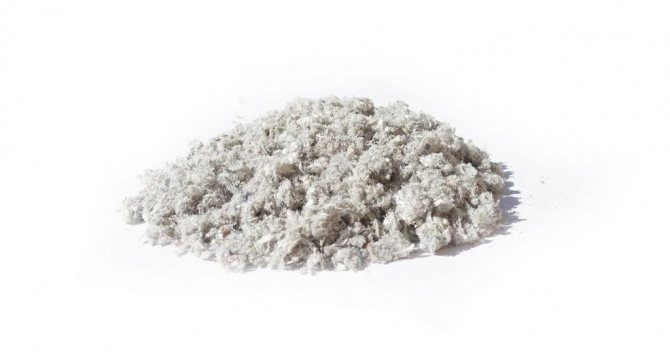

View gallery
For floor
In any construction, the utmost attention is paid to thermal insulation. The insulation of the floor has not been disregarded either. Bulk insulation is best suited for this.
The most common among them are:
Expanded clay in floor insulation is the most massive insulation material. Low price, mass production and high thermal insulation properties played an important role in this. And, although it is made from clay, the result is a fairly light product. Weight of 1 m³ on average 350 kg.
It is appropriate to mention that expanded clay is the most environmentally friendly material. Not susceptible to moisture and at the same time frost-resistant. Sold in bags or in bulk. Expanded clay can be used as an independent insulation or in combination with concrete. Expanded clay concrete not only retains heat, but in addition is also a very strong substrate, base.
The next representative of bulk insulation will be perlite. Its origin is volcanic rocks.
A distinctive, only inherent feature, a high percentage of moisture absorption. Studies have shown that it is able to absorb four times its own weight in moisture. It is because of this that it is recommended for warming rooms with high humidity.
Environmentally friendly natural material that does not enter into any chemical reactions. Possesses high fire resistance.
Withstands temperatures up to 900ᵒ C. With a porosity of up to 40% it is an excellent insulation. For insulation, it is used in the form of perlite sand. You can buy it in the same way as expanded clay, in bags or in bulk.
Vermiculite is also an excellent natural insulation. Differs in its hardness. Along with high fire resistance (up to 1200ᵒC), it has an impressive moisture absorption coefficient - more than 530%. Possesses amazing thermal insulation properties.
Related article: How to remove oil paint from a concrete wall
With a layer thickness of only 5 cm, heat loss is reduced by 75%. It is an environmentally friendly material. Possesses high chemical and biological resistance. Prevents mold and mildew growth. Having a small volumetric weight, it does not create a load on the foundation. It is sold, like all bulk insulation - in bags and in bulk.
For floor insulation, not only bulk insulation is used. Polyfoam, mineral wool, liquid insulation, cork and a number of others are also often used. Each of them has both positive and negative sides. Some are very good, but expensive. For example, cork insulation. Others, like Styrofoam, are not fire resistant.
A good floor insulation is obtained from ordinary sawdust, but it requires special antiseptic treatment... In addition, it shrinks very quickly and cakes. The most optimal parameters for floor insulation are bulk insulation.
Expanded clay
Expanded clay - ugly, but time-tested.
Probably the oldest and well-known backfill insulation is expanded clay. It is made of clay by firing. Depending on the size of the fractions, it can be in the form:
- gravel;
- rubble;
- sand (dropout).
It should be noted that expanded clay is much cheaper than its competitors, namely perlite and vermiculite, which we will talk about a little later. The density of the material can vary between 250-800 kg / m. cub. The degree of thermal conductivity ranges from 0.10 to 0.18 W / m * C.
Expanded clay practically does not absorb moisture, this process is very slow. But, having collected water, he is very reluctant to part with it, which cannot but affect its characteristics.
It is used as a bulk insulation for walls, floors, ceilings and roofs. They also read ““. It does not enter into any chemical reactions, mold does not start in it, and mice do not live in it. Since the starting material for the manufacture is clay, expanded clay has all its positive qualities:
- does not harm health;
- does not burn;
- does not contain poisons.
Expanded clay can be mixed with sawdust, but at the same time the insulation layer should be slightly larger, since wood has a slightly lower heat transfer resistance.
For walls
To keep warm in the house, you need to insulate not only the floor, but also the walls. And not only from the inside, but also from the outside. The choice of heaters is large, but I want to choose the best of them. To do this, you need to familiarize yourself with the characteristics of insulation and choose the one that suits the most.
The following materials are widely used for wall insulation:
The list of heaters is represented by a very wide range. Bulk insulation is still in great demand. The same old proven heaters that are used for the floor have proven themselves excellently. More modern ones also appeared. For example, foam glass is very popular among builders.
This environmentally friendly material is chemically resistant and does not lend itself to biological degradation. Granular foam glass is used not only as an independent backfill, but also as a base for heat-insulating plaster. It is obtained from foamed raw granules. It is produced in the form of slabs, crushed stone and in granular form of various fractions.
Penoplex - granules made of foamed polymers. It is realized in the form of slabs or chips. Absolutely non-absorbent... Very lightweight material. Requires protection from sunlight and chemical attack.
For work on wall insulation, loose foam is very convenient. Especially when making the walls of the frame structure. Having in its composition very small granules (from 0.1 mm), it is able to penetrate into the smallest voids.
Mineral wool is widely used for insulating not only walls. Granule size from 10 mm. Has good vapor permeability. Fire resistant. Does not change its properties up to 1000ᵒ С. Good sound insulator. Recommended for internal insulation. Sold in bags, in bulk, in rolls. When working with mineral wool, it is necessary to take measures to protect the respiratory tract and skin.
Summing up, we can confidently note that as a heater for walls, the leading place is occupied by bulk insulation.
For floor insulation with complex geometry, roll insulation is best suited. Details here: https://teplo.guru/uteplenie/utepliteli/rulonnyiy.html
For ceilings
Just like floors and walls, ceilings require insulation. The insulation materials discussed above may well be used in this case.
A more specific insulation is penoizol. In appearance, it somewhat resembles foam crumbs. This is where the similarity ends, if we do not take into account the characteristics of thermal conductivity.
Penoizol is absolutely non-flammable. Possesses high chemical and biological resistance. Rodents bypass him. For insulation of ceilings, it is good because it has a very low weight. Its density is from 5 to 75 kg / m³. Due to the low thermal conductivity, the thickness of the insulation layer is sufficient from 5 cm. During work, bulk material is used, in sheets and in liquid form.
Considering bulk insulation for the ceiling, one cannot ignore such a widely used material as sawdust. Sawdust is used for insulation as the cheapest material. As an independent insulation, their use is highly undesirable. The fact is that they are prone to decay due to moisture absorption.
They are also an excellent breeding ground for mice. Even if we do not take into account the fact that they are a fire hazardous material, it is not difficult to conclude that they are unsuitable. "Craftsmen" go to all sorts of tricks in order to somehow reduce these negative factors. For this, sawdust is mixed with expanded clay, lime, even broken glass and other building materials. Such measures somewhat improve the properties of the insulation, but not much.
As a conclusion, it should be noted that when insulating ceilings, the advantage is on the side filling heat insulating materials.
Draft dry backfill
The main disadvantage of dry backfills is that they settle and form voids. Therefore, if they are used, then the walls are erected 20-30 cm above the level of the ceiling beams, completely filling with backfill. As it settles, the backfill will fill the empty space. It is better to replace the backfill under the windows with fibrous or tiled materials. If there are none, retractable window sills are mounted in order to fill up the backfill through them.
In order for the insulating backfill to become less free-flowing, materials should be mixed in to it, which will turn it into a solid filler. For example, take 85% sawdust and mix it with 10% fluff lime and 5% gypsum. In this case, the sawdust will harden and turn into the so-called thermolite. For such a mixture, wet, not specially dried, organic materials or sawdust are used. Sawdust is mixed with fluff, then this mixture is added to gypsum and immediately laid out in place, leveling and compacting well. The moisture present in the filler will slightly moisten the gypsum and it will set. The aggregate will turn into a loose mass, thicken, and due to this it will not settle.
Advantages of bulk insulation
Everyone is interested in insulating their home. It remains to choose the right insulation material. Bulk insulation is best suited for this.
Their advantages are obvious:
- environmentally friendly material;
- are lightweight;
- excellent heat retention;
- fireproof;
- easy to use when working with them;
- durable.
Backfill heaters easily penetrate into any space, do not leave gaps... The main thing is to find the right faction, and success will be assured.
Watch the video in which the specialist tells how to insulate the ceiling with a mixture of vermiculite and sawdust:
Loose heaters: varieties and scope


Among the insulating materials used to reduce the transmission of sound and heat to the environment, bulk insulation is the most affordable.
Related article: How to properly prepare walls for painting
These materials can be used to fill any space in building structures. Such insulation does not lead to a violation of the finish or structure - the insulation is suitable for all cases where it is impossible to use traditional plates or roll insulation.
What does it consist of?
Generally speaking, bulk types of insulation are secondary raw materials. For production, recycled waste is used: cellulose (waste paper), glass (20-30% of the fiber consists of broken containers) and minerals (post-industrial materials - up to 75%). Some brands of insulation include perlite, vermiculite, and polystyrene beads.
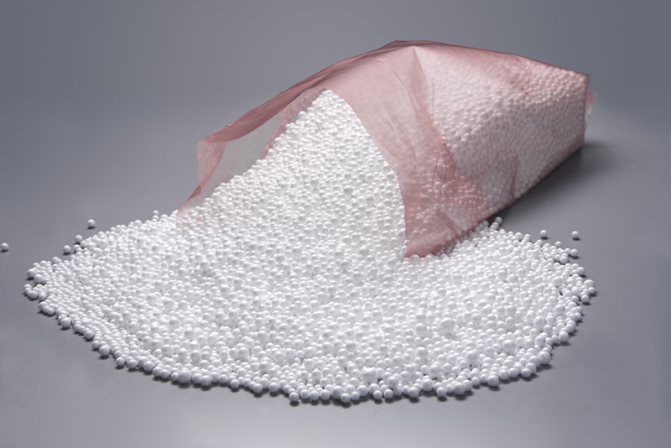

In order for the insulation work to be beneficial, it is necessary to ensure the correct density. Therefore, professionals often work with cellulose and fiberglass. Granules of vermiculite, perlite and polystyrene are easier to install - they are usually poured into prepared cavities of a building structure.
Advantages and disadvantages
Loose types of insulation in the majority refer to environmentally friendly insulation (if natural materials were used in the production process). For example, perlite or perlite crushed stone is cast from glass of volcanic origin. Vermiculite is also of mineral origin - granules are formed during the heat treatment of certain rocks. Polystyrene (polymer insulation) does not possess such characteristics - its granules, during long-term operation, begin to emit styrene into the environment.
The operational advantages of mineral insulation:
- perfectly let steam through, not allowing the walls to get damp;
- serve for a long time without loss of technical characteristics;
- resistant to open fire - withstand temperatures from 1,000 degrees;
- not interested in rodents and insects;
- do not collapse under the influence of high humidity;
- do not lose their shape - granules or crushed stone do not split over time.
The disadvantages include the need to build an additional partition (insulation is filled up between the facing material and the wall). As a result, it requires an expansion of the foundation.




